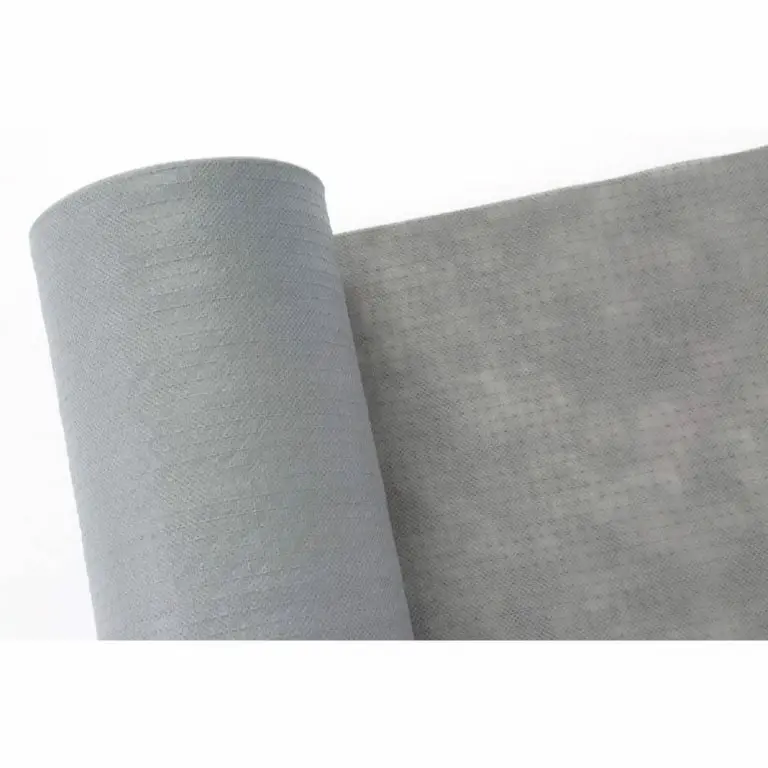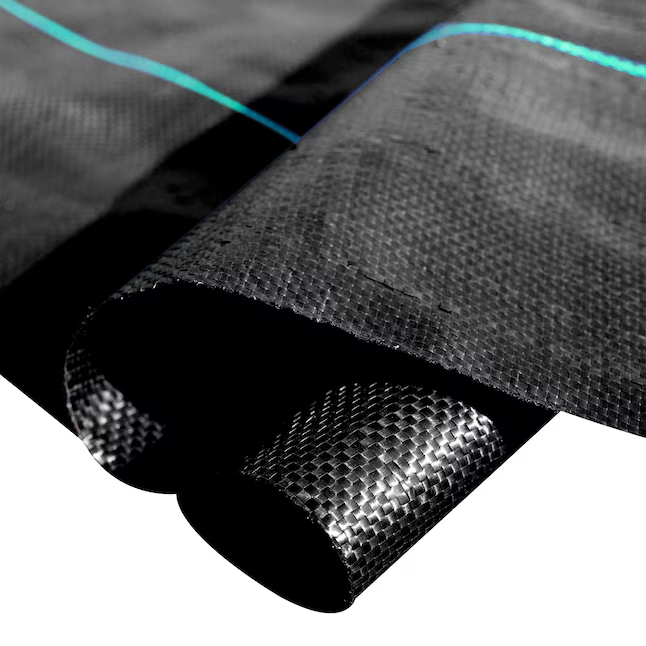What Is Weed Fabric?
Weed fabric (aka landscape fabric or weed barrier) is typically a woven or non-woven synthetic material laid down before covering with gravel, bark, mulch, or pine straw. It's designed to block weed growth while still allowing water and air to penetrate the soil.
✅ Advantages of Using Weed Fabric
1. Weed Suppression (Short-Term) The primary reason people use weed fabric is to prevent weed growth. It can significantly reduce weeds, especially in the first 1–2 years after installation. However, it only blocks weed growth from existing weeds in the soil below. Weeds that sprout from seed after installation will still be able to grow. We see this all the time with new mulch installations. The weed fabric stops old weeds from coming through, but seeds that were unintentionally mixed in with the new mulch will sprout on top of the fabric.
2. Soil Erosion Control In sloped areas or places with loose soil, the fabric helps stabilize the ground and reduces erosion beneath gravel or mulch.
3. Cleaner Look Weed fabric prevents soil from mixing with gravel, which can help keep paths or decorative stone areas looking tidier longer.
4. Foundation for Groundcover Some soil types (especially here in Florida) do not support a heavy groundcover like landscape gravel or rock. After rains, the gravel or rock will begin to sink into the soil and eventually disappear. Landscape fabric will help keep the gravel or rock above the soil surface helping it to last longer. This typically does not apply to mulch, bark, or pine straw as they are generally not heavy enough to sink in soils.
5. Improved Drainage Quality thin and light landscape fabric allows water to pass through, helping avoid pooling while still protecting the soil from being compacted by gravel. Thick and heavy fabrics can be used in areas where water runoff is desired.
⚠️ Disadvantages of Using Weed Fabric
1. Weeds Still Grow (Eventually) Over time, dust and organic matter build up on top of the fabric. This creates a layer where weeds can grow — on top of the fabric — making removal harder. The fabric makes a perfect place for sprouting weeds to root and grow. The mesh material is a perfect place for roots to grab a hold of.
2. Poor Soil Health Weed fabric can inhibit natural processes like decomposition and earthworm activity. It blocks organic matter (like mulch) from enriching the soil underneath.
3. Difficult to Maintain If weeds start growing on top or fabric tears, it’s a pain to fix. Also, if you ever want to replant or move things around, the fabric becomes a nuisance.
4. Mulch Slips Off Wood mulch tends to slide off smooth fabric more easily, especially on slopes, making it less effective and less aesthetically pleasing over time. Florida summer rains can cause mulch to float away in some places. Since water can take longer to absorb through some landscape fabrics, mulch may float in the rainwater. If the area is not flat, mulch may be carried “downstream” from where it was installed.
5. Cost & Labor Fabric adds to the cost of your project and takes extra time to install properly — cutting around plants, securing edges, and overlapping seams.
💡 When to Use It (and When Not To)
Best Use Cases:
Under gravel in walkways or decorative areas where you won’t plant.
In areas with aggressive weed problems where short-term control is key such as in the original install.
On slopes to stabilize gravel or soil temporarily.
Areas where chemical weed maintenance can be used instead of hand pulling.
Not Ideal For:
Garden beds with perennials or annuals.
Vegetable gardens (opt for thick layers of mulch or cover crops instead).
🌱 Alternatives
Thick layers of mulch or pine straw (3–4 inches): Naturally suppress weeds and enrich the soil over time.
Cardboard or newspaper layers: Biodegradable and effective for smothering weeds temporarily.
Living groundcovers aka Green Mulch: Low-maintenance sprawling growth habit plants that crowd out weeds naturally. There are some options like Perennial Peanut that also help amend soil through nitrogen fixing.
Specifications and Products
Product Thickness can be measured in millimeters (mm) or in weight by square yard commonly expressed as a number of oz. Products showing mm are obviously showing a measured thickness. Products showing thickness in oz are expressing a weight per square yard that correlates to their thickness and durability.
Common Landscape Fabric Weight Categories
Weight: 3 oz/yd²
Thickness Level: Light
Best For: Garden beds, short-term weed control under mulch
Weight: 4–5 oz/yd²
Thickness Level: Medium
Best For: Under gravel, long-term mulch beds, paths
Weight: 6+ oz/yd²
Thickness Level: Heavy
Best For: Commercial landscaping, driveways, high-traffic areas
Please Note Manufacturers use terms like "Heavy Duty" in product names and descriptions for marketing purposes. Make sure to check the product specifications to determine if the product is suitable for your intended use.
Product width and length per roll helps to determine how the fabric will arrive and how it can be used for installation. For the easiest installation, choose a roll width that is close to the width of the area that you wish to install.
Method of securing is the manufacturer's recommended way to keep the fabric secured in the ground. The most common method is metal landscape staples that are driven in by a mallet or can be pushed in by hand in soft soils.
Woven and Nonwoven are additional options when selecting a fabric. Woven fabrics offer higher strength, better weed suppression, and are recommended for gravel and rock. They also help with moisture retention in the soil below. But, they do not allow water and air to transfer through the fabric as well as nonwoven fabrics do. Nonwoven fabrics are bonded together for thickness and are easier to cut and shape. They allow better drainage but are less durable and break down faster. Nonwoven fabrics are best for drainage projects or for areas where rainwater needs to be allowed to drain through.
Type of material can help determine if certain products will fit your needs. Most landscape fabrics are made from polypropylene which is similar to a plastic burlap. Other fabrics may be made from a synthetic felt, biodegradable paper, plastic, and even hemp. Polypropylene can allow air and moisture to penetrate through the material. Thickness and woven vs non-woven will directly affect the permeability of the fabric. Additionally, you may see some products listed as “needle-punched”. This feature increases the permeability of thick woven fabrics for better drainage comparable to thinner non-woven fabrics.
Ashman Heavy-Duty Landscape Fabric Weed Barrier

Product Length and Width: Multiple Options
Product Thickness: 0.15mm
Fabric Type: Woven Polypropylene
Biodegradable: No
Manufacturer Warranty: 1-Year
Availability: Home Depot / Manufacturer Website
Cisvio Heavy-Duty Landscape Fabric Weed Barrier with U-Shaped Securing Pegs

Product Length and Width: Multiple Options
Product Thickness: 0.18mm / 3.5oz per sq.yd
Fabric Type: Woven polypropylene
Biodegradable: No
Manufacturer Warranty: 30-day guarantee
Availability: Home Depot
Vigoro Heavy-Duty Grid Landscape Fabric

Product Length and Width: Multiple Options
Product Thickness: 0.43mm - .52mm
Fabric Type: Non-woven (material type not listed)
Biodegradable: No
Manufacturer Warranty: Limited Life-time
Availability: Home Depot / Manufacturer website
SVOPES Garden Fabric Weed Barrier

Product Length and Width: 100ft x 4ft or other options
Product Thickness: 4.7mm / 5.8oz per sq.yd
Fabric Type: Woven polypropylene
Biodegradable: No
Manufacturer Warranty: 1-year
Availability: Home Depot / Lowes
Sandbaggy Heavy-Duty Landscape Fabric Weed Barrier

Product Length and Width: 4ft wide x 30ft long – 4ft wide x 300ft long
Product Thickness: 3-3.2 oz / sq.yd
Fabric Type: Woven Polypropylene
Biodegradable: No
Manufacturer Warranty: None but claim 40-year life if not exposed to UV light
Availability: Manufacturer website
Farmtek Heavy Duty Ground Cover

Product Length and Width: 100 or 300 ft long x 3ft to 12 ft wide
Product Thickness: 4.1 oz/ sq.yd
Fabric Type: Woven Needle-punched polypropylene
Biodegradable: No
Manufacturer Warranty: Not listed
Availability: FarmTek website

Final Thoughts
Weed fabric can be a useful tool — but it’s not a one-size-fits-all solution. It works best for non-planting areas with gravel or as a temporary measure of weed control. Long term, it can create more problems than it solves if used improperly.
Have you had good or bad experiences with landscape fabric? Keep the conversation going by commenting below!
_edited.png)




